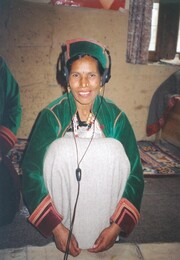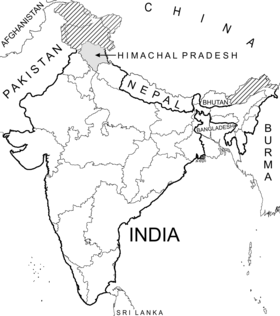Contact person: Christian Huber
The district Kinnaur of the State of Himachal Pradesh in the Indian Himalayas has long been known as an area of great linguistic diversity, being the home not only of varieties of Tibetan but also of various West Himalayish and Indo-Aryan languages. All of these languages and dialects, often spoken only in a few villages, are endangered to varying degrees, and many among them are largely undocumented.
The Phonogrammarchiv’s research focus Researching and documenting endangered languages of Kinnaur (Himachal Pradesh, India), as well as the collection focus on West Himalayish languages, grew out of the Austrian Science Fund project P15046 Documentation of Oral Traditions in Spiti and Upper Kinnaur, which was carried out at the Phonogrammarchiv from September 2001 to June 2004. At that time not much had yet been known about the actual complexity of the language situation in Kinnaur; the existence of several languages spoken there that had been detected in the 19th century was over time forgotten, and more extensive documentation was available only for Kinnauri. The Oral Traditions project managed to establish contact with speakers from a number of linguistic groups and began the systematic research on Shumcho/Humcho, Jangrami (both West Himalayish), and the Indo-Aryan language of the lower castes in lower Kinnaur. In a follow-up field trip in 2007, research was begun also on the language of the high caste in Sunnam, which is spoken in no other village. The data showed that the language belongs to a different subgroup of West Himalayish than the other West Himalayish languages of Kinnaur.
Shumcho/Humcho is spoken by all castes in the region comprising the three villages of Kanam, Labrang and Spillo, while in the Jangram region it is spoken by the lower castes (in Jangi, Lippa and Asrang); it is also spoken in the Ropa valley in Shyaso, Rushkalang and Taling (apparently by all castes) and by the lower caste(s) in Sunnam, where Sunnami is the language of the high caste. Jangrami (Ethnologue: Jangshung) is the language of the high caste in Jangi, Lippa and Asrang. The Indo-Aryan low caste language, sometimes referred to as Oras Boli (Ethnologue: Kinnauri Harijan), is found throughout central and lower Kinnaur in villages where the high caste speaks Kinnauri or Chhitkuli.
As a consequence of modern life finding its way also into remote Himalayan villages, all these languages are under increasing pressure from Hindi. The influence of Hindi, which is the administrative language as well as the language of instruction in schools and also the language of the mass media (TV, Bollywood, newspapers, etc.), can be felt at all levels and constitutes a serious threat to the long-term survival of the small languages. Nowadays all speakers are bilingual with Hindi, and it can already be observed in many places that children are raised exclusively in Hindi and that the local languages are no longer passed on to them – a trend which is not likely to be reversed. Research on these languages together with documentary work is therefore a matter of urgency.
Since previously next to no research had been done on any of these languages, the project engages not only in investigating the lexicon, phonology and grammar (morphology, syntax, semantics) of the respective languages but also in building a body of resources such as an annotated (translated, glossed, analyzed and commented) corpus of recorded “texts” (e.g. narratives, conversations/interviews, etc.) and other linguistic materials that document the language in its actual use in different situations and contexts, accompanied by ancillary videographic documentation. All primary data are collected in fieldwork. Thanks to the well-established contacts with local speakers in Kinnaur the research activities can be also carried on via modern communication media when there is no possibility to travel to the research area. The project is thus firmly embedded in the Phonogrammarchiv’s infrastructure: it ensures the combination of fieldwork and research, audio-visual documentation, and archiving under a single roof. Constituting a part of the Phonogrammarchiv’s Himalayan key collection, the project thereby not only contributes to the Phonogrammarchiv’s holdings but interfaces synergetically, and to mutual benefit, with various key areas in the Phonogrammarchiv’s agenda such as fieldwork experience, field recording methodology, or the description and organization of data and audio-visual documentation, and the archiving thereof.
The project’s findings are disseminated in scholarly articles and talks as well as lectures for the general public, and are also made available to the speakers themselves. Data from this research are further utilized in an comparative work in international cooperation in order to shed more light on the internal structure of the West Himalayish group of languages.
Publications
Huber, Christian. 2023b. “Gender marking in Shumcho”. To appear in Nominal Classification in Asia and Oceania. Functional and diachronic perspectives(=Current Issues in Linguistic Theory 362),ed. by Marc Allassonnière-Tang and Marcin Kilarsky, 58–112. Amsterdam: John Benjamins.
www.researchgate.net/publication/376551351_Chapter_4_Gender_marking_in_Shumcho
Huber, Christian. 2019. “Progressivity and habituality in Shumcho”. STUF – Language Typology and Universals 72(1), 83–132.
https://www.researchgate.net/publication/331403003_Progressivity_and_habituality_in_Shumcho
Huber, Christian. 2017. Selected Topics in the Grammar of Shumcho/Humcho, Texts, and a Shumcho-English Glossary. PhD dissertation: University of Vienna.
Huber, Christian. 2014. “The Verbal Plural Marker in Shumcho”. Complex Visibles Out There. (=Olomouc Modern Language Series 4) ed. by Ludmila Veselovská and Markéta Janebová, 193–216. Olomouc: Palacký University.
Huber, Christian. 2013. “Subject and object agreement in Shumcho”. Trans-Himalayan Linguistics (=Trends in Linguistics: Studies and Monographs 266), ed. by Thomas Owen-Smith & Nathan W. Hill, 221–274. Berlin, Boston: de Gruyter.
www.researchgate.net/publication/364862714_Subject_and_object_agreement_in_Shumcho
Huber, Christian. 2011. “Some notes on gender and number marking in Shumcho”. Jahrbuch des Phonogrammarchivs der Österreichischen Akademie der Wissenschaften 2 ed. by Gerda Lechleitner & Christian Liebl, 52–90. Göttingen: Cuvillier.
Huber, Christian. 2007. “Researching local languages in Kinnaur”. Um-Feld-Forschung: Erfahrungen – Erlebnisse – Ergebnisse ed. by Julia Ahamer & Gerda Lechleitner, 249–266. Wien: Verlag der Österreichischen Akademie der Wissenschaften.
see also Talks




